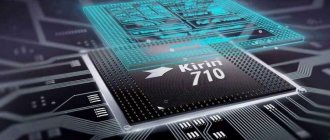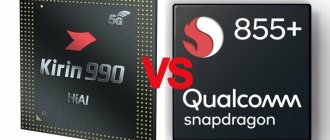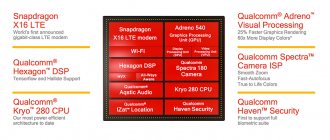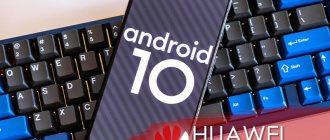Huawei Kirin 710 is an analogue of Qualcomm Snapdragon 710, but only in name - review and specifications
This article will be short and it is mainly necessary to complement this topic with the Huawei Nova 3 .
First, let's look at Kirin processors - Huawei has one such middling one, the Kirin 659, which the company actively uses in inexpensive smartphones costing up to 20,000 rubles. Kirin 659 is a kind of analogue of Snapdragon 625, but weaker and more ancient in technology. Firstly, it is made using a 16-nanometer technical process (versus 14 nm for SDM625), which is generally not bad, but not so attractive. The second point is the frequency of the cores - this is Cortex-A53 with a frequency of up to 2.36 GHz in the upper block and 1.7 GHz in the lower one. Snapdragon 625 offers a frequency of 2 GHz simultaneously in eight cores, and it is not divided into blocks. Naturally, the solution from Qualcomm ends up being more profitable, flexible and productive. Thirdly, the Mali-T830 MP2 graphics in the Kirin 659 cannot be compared with the Adreno 506 in the Snapdragon 625. Many may exclaim, but how can this be, because the Kirin 659 is more powerful, albeit not by much, in Antutu they will be right . Scores in Antutu do not reflect real power, since some processes are tested in the benchmark, but in reality they are somewhat different. Moreover, in multi-threaded Geekbench, the Snapdragon 625 scores about 4000 points, and the Kirin 659 scores around 3300 points (in single-core mode everything is about the same). This is how it turns out that although the Kirin 659 is a mid-budget solution, in terms of real performance the processor can rather be classified as a budget class.
That's why all this was written - Huawei is preparing a sub-flagship called Kirin 710, which should become some kind of alternative to the Snapdragon 710. However, in reality, everything will be completely different from what the manufacturer wants, since the 710 Kirin is an improved modification of the 659, and Snapdragon 710 and 625 are radically different solutions and there is not a gap between them, but a whole abyss. Snapdragon 625, 630, 636, 660 and only then 710!
But still, let's compare what the 710th Dragon offers and what the 710th Kirin is preparing - maybe not everything is so sad for Huawei?
| Qualcomm Snapdragon 710 | Huawei Kirin 710 |
|
|
Not all points are clear with this processor from Huawei, but even so it is clear that the SoC from the Chinese manufacturer will not be able to compete with Qualcomm. However, he won’t even try, since this is all designed for the consumer, they say, look, we have an analogue of the Snapdragon 710 - take our Huawei or Honor smartphones. In fact, the Kirin 710 will not be much more powerful than the Snapdragon 636. This is not bad, in fact, but sub-flagship performance is out of the question here - it’s pure average.
Huawei P Smart S presented with Kirin 710F and triple camera, but without Google services
Huawei has quietly expanded its line of P Smart smartphones with a new model. This is Huawei P Smart S, a mid-class smartphone based on the Kirin 710F platform and with a triple main camera. But first things first.
Telegram channel of the creator of Trashbox about technology
Telegram channel of the creator of Trashbox about technology
On the front, the Huawei P Smart S has a 6.3-inch OLED display with a U-shaped cutout on top for the camera. The panel has a built-in fingerprint scanner for biometric authentication. On the back of the body there are three cameras, which, together with the flash, are aligned vertically. It has a 48-megapixel main sensor with an 8-megapixel wide-angle camera and a 2-megapixel depth sensor for portrait photos.
Hidden inside the Huawei P Smart is the proprietary eight-core Kirin 710F chipset, accompanied by 4 GB of RAM and 128 GB of internal memory, expandable using an NM card. The device is powered by a 4000 mAh battery. It charges via the USB Type-C port with a maximum power of 10W. Other characteristics of the new product include a 3.5 mm headphone jack, NFC, Bluetooth 5.0 and Wi-Fi.
The device runs on the Android 10 mobile operating system with the EMUI 10.1 shell installed on top. It, like most new Huawei smartphones, does not have Google services, including the Play Store. They are being replaced by alternative services Huawei Mobile Services (HMS) with AppGallery.
Huawei P Smart S is already available for purchase in Europe. Thus, it can be ordered on the official website of Huawei in Italy for only 259.90 euros. It is offered in two gradient colors: blue and black.
Technical characteristics of Huawei P Smart S:
- Display: 6.3-inch, OLED, 2400x1080 pixels, Full HD+, pixel density 418ppi.
- SoC: Kirin 710F, 12nm process technology, octa-core processor (4 Cortex-A73 cores @ 2.2 GHz and 4 Cortex-A53 cores @ 1.7 GHz), Mali-G51 MP4 graphics.
- RAM: 4 GB.
- Internal memory: 128 GB + support for Nano Memory cards (up to 256 GB).
- Front camera: 16 MP (f/2.0), HDR.
- Main camera: triple, 48 MP (f/1.8) + 8 MP (f/2.4, wide-angle lens with a viewing angle of 120 degrees) + 2 MP (f/2.4), LED flash, HDR, panorama.
- Operating system: Android 10 with EMUI 10.1 shell and Huawei Mobile Services.
- Battery: Li-polymer, 4000 mAh, supports 10 W fast charging.
- Fingerprint scanner: optical, built-in display.
- Communications: 4G LTE, FM radio, NFC, Wi-Fi 802.11 a/b/g/n/ac (dual-band), Bluetooth 5.0, A-GPS, GLONASS.
- Ports: USB Type-C, 3.5 mm audio jack.
- Case dimensions: 157.4 x 73.2 x 7.8 mm.
- Weight: 163 g.
- Available colors: blue and black.
Kirin or Snapdragon - which smartphone processor is better in 2022?
It cannot be said that the Kirin 710 was one of the first chipsets that Huawei began to package in its own smartphones. However, it is not fresh either. Its announcement took place in 2022. By that time, the production of chips using the 12-nanometer process technology
was mastered quite a long time ago, so this model turned out to be very cheap. It consists of eight cores, half of which operate at 2200 MHz, and the rest at 1700 MHz. The chip's competitor is the Snapdragon 460. It was introduced in early 2022. It was designed specifically for installation in budget smartphones. To create it, the 11 nm process technology was used. The chip consists of eight cores. They are made using different architectures, but the operating frequency is the same - 1800 MHz.
As a graphics accelerator
Kirin 710 received Mali-G51 MP4. It would be hard to call it particularly powerful. However, it greatly outperforms the Adreno 610 that its competitor has. A smartphone based on the HiSilicon chip can be safely used to run games. If you activate medium graphics settings, you can expect a stable 60 frames/s. And World of Tanks Blitz even on ultra settings produces 52 fps. If you run this game on a device with a Snapdragon 460 on board, then even on medium settings you will see an average of 42 fps. And this is with a not-so-high display resolution!
Regarding RAM
, then Kirin 710 is capable of recognizing up to 6 GB.
More is not needed, because manufacturers of budget smartphones are not able to be generous even with such a volume. However, it must be admitted that theoretically Snapdragon is ready to beat its competitor by recognizing 8 GB. It also achieves a small victory on the supported cameras
. Yes, both processors are ready to record video with a resolution of no more than Full HD and a frequency of 60 frames/s. But the Kirin 710 only understands data from a 40-megapixel camera, while the Snapdragon 460 is ready to receive an image with a resolution of 48 megapixels.
The Kirin 710 has one serious problem. A smartphone based on this processor is not capable of providing high-speed communications
. No, in terms of operation of the LTE modem, everything will be fine. But if you want to use Wi-Fi, the speed of receiving and transmitting data will be quite low. However, does a budget smartphone need high? Qualcomm hasn't thought about this issue. Even its cheapest chip is ready to please with support for Wi-Fi 802.11ax. It also has a built-in Bluetooth 5.1 module, which will especially appeal to owners of high-quality wireless headphones. The Chinese competitor is limited to Bluetooth 4.2.
If we talk about the prevalence of these chipsets, the Kirin 710 is gradually becoming a thing of the past. Interestingly, it was used not only by Huawei, but also by many other Chinese smartphone manufacturers. For example, Xiaomi Redmi Note 10, which is still in demand, and Vivo V20 SE were created on its basis. Budget chips from Qualcomm are found a little more often in smartphones. In particular, Vivo Y20, OnePlus Nord N100 and Nokia G10 have it.
| Index | Kirin 710 | Snapdragon 460 |
| Specifications | ||
| Technical process | 12 nm | 11 nm |
| Cores | 4x2200 MHz, 4x1700 MHz | 8×1800 MHz |
| Graphics accelerator | Mali-G51 MP4, 650 MHz | Adreno 610, 600 MHz |
| RAM | up to 6 GB | up to 8 GB |
| Video recording | 1080p, 60 fps | 1080p, 60 fps |
| Download speed | up to 600 Mbit/s | up to 390 Mbit/s |
| AnTuTu | 201,000 points | 162,000 points |
| Criterion scores | ||
| CPU performance | 4.35 | 4.10 |
| Energy efficiency | 4.20 | 4.25 |
| Graphic arts | 4.35 | 4.15 |
| Prevalence | 4.10 | 4.25 |
| Camera support | 4.30 | 4.30 |
| Wireless standards | 4.25 | 4.15 |
| Memory | 4.35 | 4.40 |
| Average score | 4.27 | 4.22 |
If you are going to at least occasionally play on your smartphone, then it is better to take a device based on the Kirin 710. However, finding one is becoming more and more difficult every day. Unfortunately, Qualcomm's product is inferior to its competitor. At least when it comes to its power. Some superiority is observed only in terms of the wireless standards it supports.
Current characteristics and description of HiSilicon Kirin processors (600, 700, 900 series)
Qualcomm Snapdragon is the most popular SoC that is installed in most modern smartphones above the ultra-budget segment. Some time ago, MediaTek could compete with them in terms of coverage, but now even Chinese manufacturers have switched to Snapdragon. However, this does not mean that Qualcomm has no competitors. There are also Apple on the market, which make chips exclusively for their Samsung devices, as well as Huawei - quite popular, powerful, but not yet so widespread. Let's talk about them.
HiSilicon Semiconductor separated from Huawei, remaining entirely under its control, in 2004. It is considered the largest Chinese integrated circuit manufacturer. Despite the lack of exclusivity, HiSilicon chips are mainly found in Huawei and Honor devices.
K3V2 (2012)
The company's first truly popular chip was a processor with the hard-to-remember name K3V2, which was used in the Huawei Ascend D Quad XL and the MediaPad 10 HD FHD7 line of tablets. Its characteristics:
- Made using 40 nm process technology
- Based on ARMv7 architecture
- Consists of 4 Cortex-A9 chips operating at 1.4 GHz
- Supports LPDDR2 memory
K3V2E (2013)
Changes compared to the previous chip:
- Received an increased frequency of 1.5 GHz
- Improved Intel Narrowband Support
Kirin 620 (first quarter 2015)
But with this chip, we can consider the clear history of Kirin systems on a chip to begin. It was used, for example, in Huawei P8 Lite and Honor 4X
- Made using 28 nm process technology
- ARMv8-A architecture
- 8 Cortex-A53 cores with a frequency of 1.2 GHz
- Support 13 MP cameras and Full HD video
- Mali-450 MP4 graphics accelerator
- LPDDR3 memory support
- Dual SIM support with LTE
- Bluetooth v4.0
Kirin 650 (Q2 2016), 655 (Q4 2016), 658 (Q2 2017), 659 (Q3 2017)
A popular series of chips that differ only in core frequency and support for different communication technologies. Used in devices ranging from Huawei P9 Lite to Nova 2
- Made using 16 nm FinFET+ tech process
- 8 Cortex-A53 cores (4 energy efficient with a frequency of 1.7 GHz; the frequency of 4 productive ones increased from 2 to 2.12, 2.35 and 2.36 GHz, respectively)
- Graphics accelerator Mali-T830 MP2
- Kirin 659 received support for Bluetooth v4.2
Kirin 710 (July 2018)
Comparison of the best mid-budget processors
This chip is intended to be something between the 650 series of processors and the flagship 900 line. The first HiSilicon processor built on the 12 nm process technology
- 8 cores: 4 Cortex-A73 at 2.2 GHz and 4 Cortex-A53 at 1.7 GHz
- Video accelerator Mali-G51 MP4
- Cat.12 modem (up to 600 Mbps)
Kirin 910 and 910T (Q1 2014)
The manufacturer's first flagship systems, which differed only in frequency, were used, for example, in the ancient, but competitive at the time of its release, Huawei P7 Ascend
- Made using 28 nm process technology
- ARMv7 architecture
- 4 Cortex A9 cores with a frequency of 1.6 GHz and 1.8 GHz, respectively
- Mali-450 MP4 graphics accelerator
- LPDDR3 memory
- Cat.4 modem
Kirin 920, 925 and 928 (2014)
Used, for example, in Huawei Honor 6
- Made using 28 nm process technology
- 4 Cortex-A7 cores (1.3 GHz) and 4 Cortex-A15 cores (1.7, 1.8 and 2.0 GHz, respectively)
- Accelerator Mali-T628 MP4
- Cat.6 modem (up to 300 Mbps)
- Supports cameras up to 32 MP
Kirin 930 and 935 (Q1 2015)
New architecture in the flagship line
- 28 nm process technology
- ARMv8-A
- 4 Cortex-A53 cores (1.5 GHz) and 4 Cortex-A53 cores (2.0 and 2.2 GHz)
- Mali-T628 MP4
- Cat.6 modem (download up to 300 Mbit/s and upload up to 50 Mbit/s)
Kirin 950 and 955 (Q4 2015 and Q2 2016)
- 16 nm FinFET+ process technology
- 4 Cortex-A53 cores (1.8 GHz) and 4 Cortex-A72 cores (2.3 and 2.5 GHz)
- Mali-T880 MP4
- LPDDR4 memory support
Kirin 960
- 16 nm process technology
- 4 Cortex-A53 (1.84 GHz) and 4 Cortex-A73 (2.36 GHz) cores
- Mali-G71 MP8
- LPDDR4 – 1800
- Cat.12 modem (600 Mbit/s download and 150 Mbit/s upload)
Kirin 970 (Q4 2017)
Still relevant, but gradually transferring rights to the new generation, the flagship chip is a competitor to Snapdragon 845 and Apple A11 Bionic
- 10 nm FinFET+ process technology
- Dedicated neuromorphic processor (Neural Processing Unit, NPU)
- 4 Cortex-A53 cores (1.84 GHz) and 4 Cortex-A73 cores (2.36 GHz)
- Mali-G72 MP12
- LPDDDR4X-1866
- Cat.18 (1.2 Gbit/s download and 150 Mbit/s upload)
Kirin 980
According to the company, it is the most powerful mobile chip on the market. The reliability of this statement will become known on October 16, when the Huawei Mate 20 series smartphones are released - the first devices with this chip on board. However, already at the time of its announcement, the system broke almost a dozen records:
- The first system built using the 7 nm process technology (it is worth noting that there is no such technology for PCs yet)
- 8 cores: 2 Cortex-A76 (2.6 GHz), 2 Cortex-A76 (2.2 GHz) and 4 Cortex-A55 (1.8 GHz)
- "Double" NPU
- The Mali-G76 accelerator was used for the first time
- Cat.21 modem used for the first time (up to 1.4 Gbit/s download)
- LPDDR4X memory with a frequency of 2133 MHz
Subscribe to our YouTube channel and never miss new videos about mobile games Subscribe











